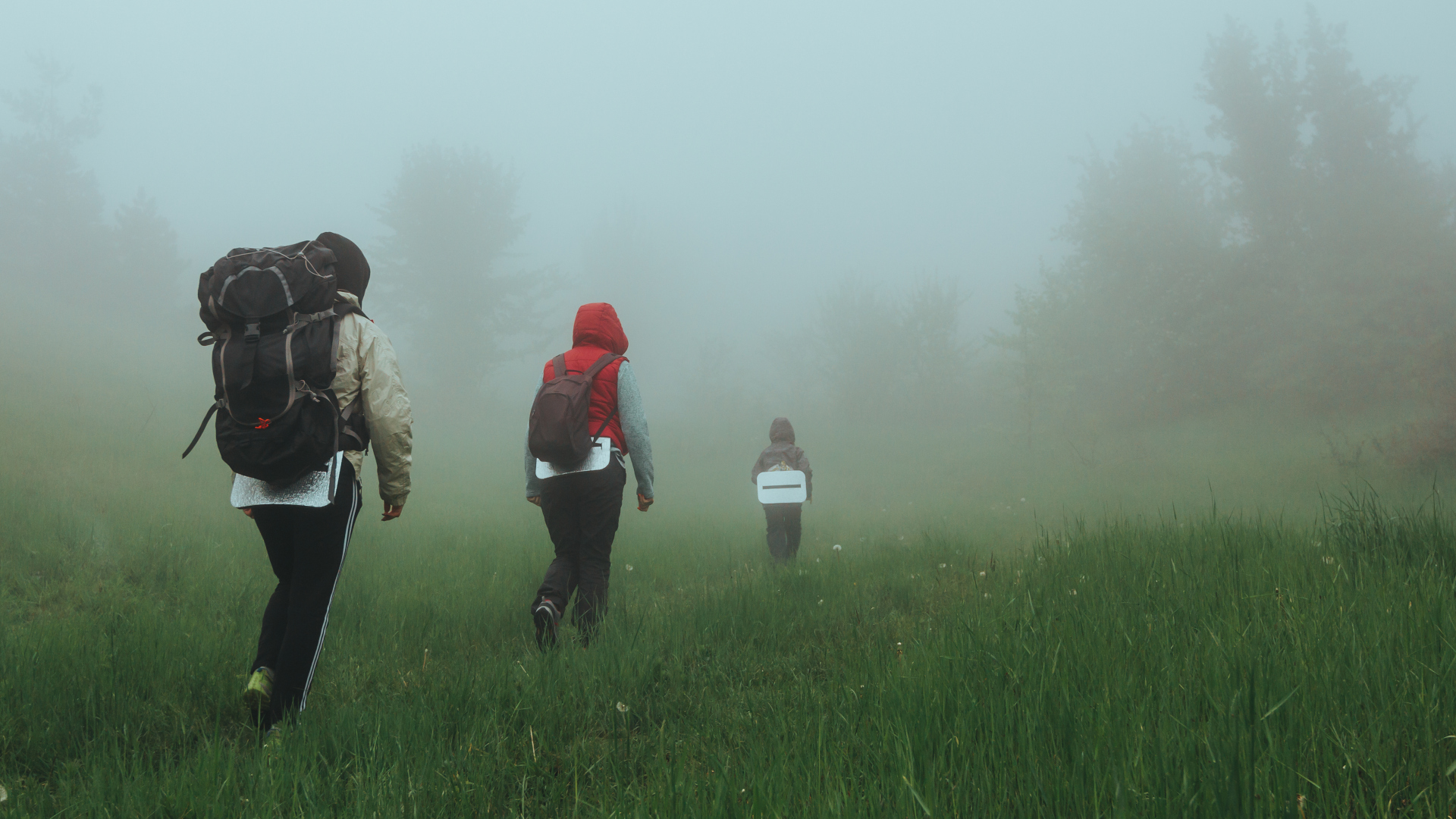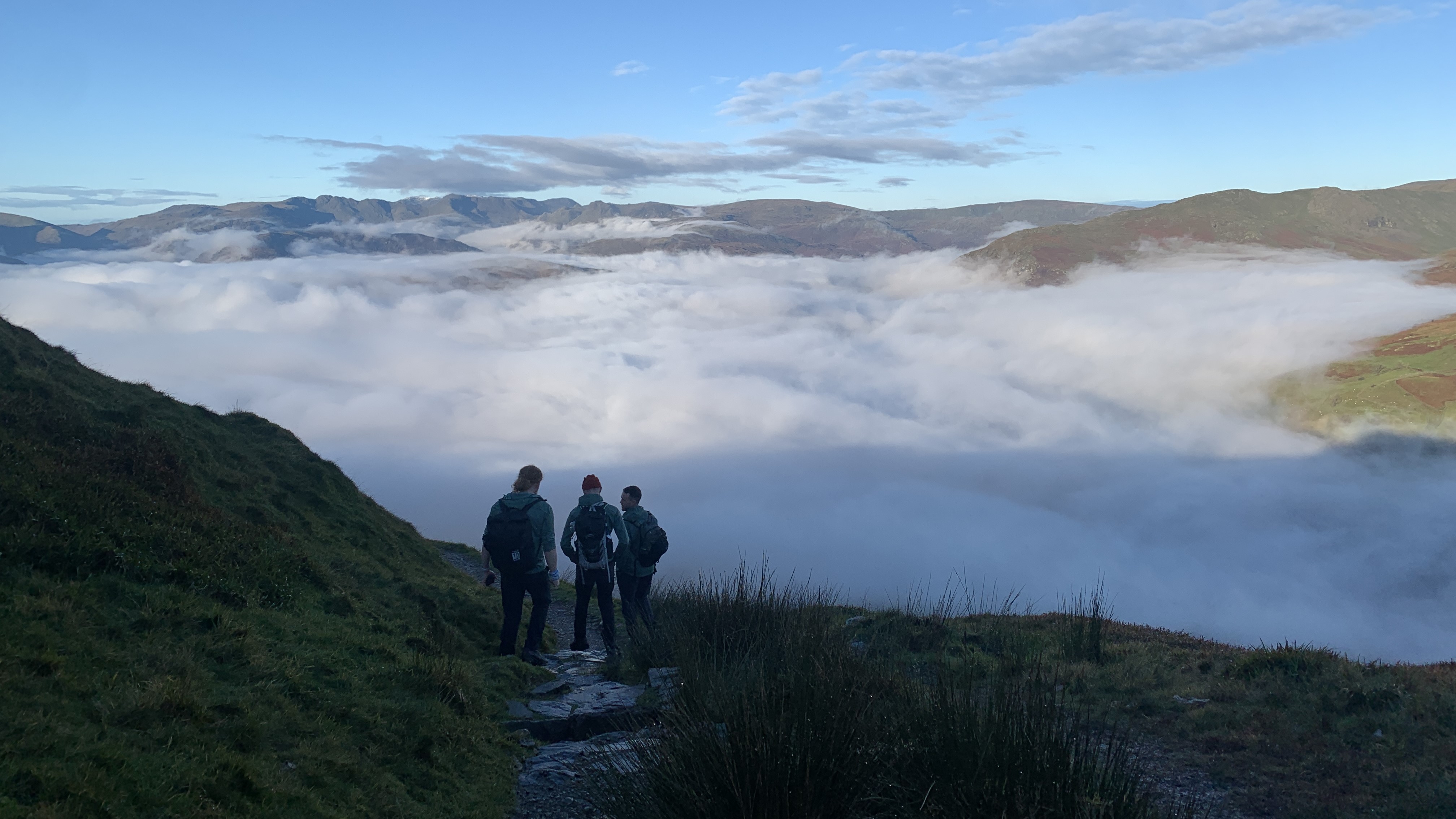What’s the point of hiking when there’s no view?
Gloomy day you say? Here’s why you should still hit the trail instead of curling up with a good book

Hiking, they say, is all about the views. Sure it’s hard work, panting as you clamber up steep slopes, your hiking boots sliding around on loose rocks that leave you in constant fear of your life, or at the very least, public humiliation. But when you get to the top and catch your breath on that expansive ridgeline gazing out across a sweeping valley, distant lakes glinting in the sunlight, it will all be worth it.
So what about those dreary days when it’s not exactly pouring hard enough to make hiking risky, but a stubborn low cloud system settles in and obscures the view entirely, and all you can see is ten feet of trail ahead of you? Is there any point in hiking when there’s no view?
Since I moved back to the UK in 2021, I’ve frequently found myself hiking in such conditions and I’ve more pictures of trig points instead of views from Munro summits than I can count. Just a few days ago I sauntered up one of the three Yorkshire Peaks in the fog. I could see the valley and the famous Ribblehead Viaduct below me but not the actual peak I was heading for. A week before that, I tackled one of my favorite mountain hikes near Glasgow on the Cobbler, a Corbett known for its distinctive rocky summit. I saw a light rain for most of the walk, some snow at the top, but what I definitely didn’t see was the rocky summit itself, or the view down towards Loch Long.

Though Scotland has plenty of sunshine, bleak days are common enough that we have over 100 words for rain, with “dreich” being my favorite. But these conditions aren’t restricted to Scotland and the rest of the UK – hikers in the Pacific Northwest and the northeast of the US will know exactly what I’m talking about.
You might think I’m disappointed to put in all that work only to have the scenery obscured by the clouds, and wonder why I don't just up and head back to the trailhead, get in my car, drive to the airport and fly back to Colorado, where the sun shines 300 days a year. If I’m being honest though, I love these misty adventures just as much as sunny ones, from the dewy mist quenching my skin to the way it smells during and after a rain. Unconvinced? Curious? Here are my five reasons for hiking in the gloom, even if you don’t get a view at the top.
1. Mood is good
Hiking when the sun is splitting the sky means you can see for miles, sure, but it basically all looks like a postcard, which can get a little boring (unless you’re in Yosemite National Park). Have you ever walked through a moody forest shrouded in fog or watched the mist swirl around jagged mountain peaks?
Gray days can make the landscape seem a million times more atmospheric, your surroundings tend to be softer and more muffled which makes you more introspective, and the whole effect can turn that picture-perfect scenery into something much more magical and mysterious.
All the latest inspiration, tips and guides to help you plan your next Advnture!

2. It makes you focus on the journey
For the entirety of any hike, you’re out in nature receiving its benefits, getting great exercise and breathing the fresh air, but if you’re hyper-focused on getting to a viewpoint at the summit, it can be too easy to miss out on all the special moments along the way. Take away the promise of a view at the end and you can appreciate all of the views along the entire journey, the changes in the trail and those tiny wildflowers that pop out against the gray backdrop.
3. It turns a gloomy day into an adventure
Though I have friends who, like me, will venture out into the hills in just about any weather, I know plenty of people who wouldn’t even think of hiking when it's drab, preferring instead to curl up at home in front of the fire. To each their own and I do appreciate a cup of tea and a good book, but as far as I’m concerned if you stay home on a gloomy day, it’s just a gloomy day. Get outdoors though and you get an adventure every time which can be a great way to beat seasonal depression.

4. The trails are quieter
Kind of like skiers, lots of hikers are fair-weather hikers, preferring to wait for the sun to come out before hauling out the hiking backpack. If you live in the Pacific Northwest, northeast or the UK, however, you could spend months waiting for a rainy day. Arrive on a summit of a clear day and you might find yourself fighting for a spot to sit down for lunch, but get out on the trail when it’s gloomy and you could have the whole place to yourself. Trust me, all that peace and quiet more than makes up for the lack of view.
5. Sometimes you’re surprised
Though the views might not be much to write home about from a cloudy summit, when the clouds are swirling, sometimes there’s a breathtaking momentary break in the fog and a shaft of sunlight illuminates the valley below – when it does, it’s the best view you’ve ever seen in your life. And if you’re really lucky, that cloudy day you set off in at the trailhead might just turn out to be a cloud inversion after all.

Hiking in the gloom: go prepared
Of course, there is one thing that could hamper your ability to enjoy yourself on a hike in the clouds, and that’s setting off unprepared. Though sometimes, all you’re dealing with is flat light and a limited view, clouds can also mean difficulty navigating and harsh weather, particularly if you’re going up in elevation. Bring the 10 essentials such as your waterproof jacket and rain pants to stay comfortable and carry a map and compass to stay safe if conditions worsen.
For really restricted visibility, it is worth sticking to lower-lying forested trails than heading up the nearest 14er, and make sure to read our tips on hiking in fog. And if you decide the weather’s simply too bad to hit the trail and want to curl up with a good book, check out our favorite hiking books for some inspiration.
Julia Clarke is a staff writer for Advnture.com and the author of the book Restorative Yoga for Beginners. She loves to explore mountains on foot, bike, skis and belay and then recover on the the yoga mat. Julia graduated with a degree in journalism in 2004 and spent eight years working as a radio presenter in Kansas City, Vermont, Boston and New York City before discovering the joys of the Rocky Mountains. She then detoured west to Colorado and enjoyed 11 years teaching yoga in Vail before returning to her hometown of Glasgow, Scotland in 2020 to focus on family and writing.

